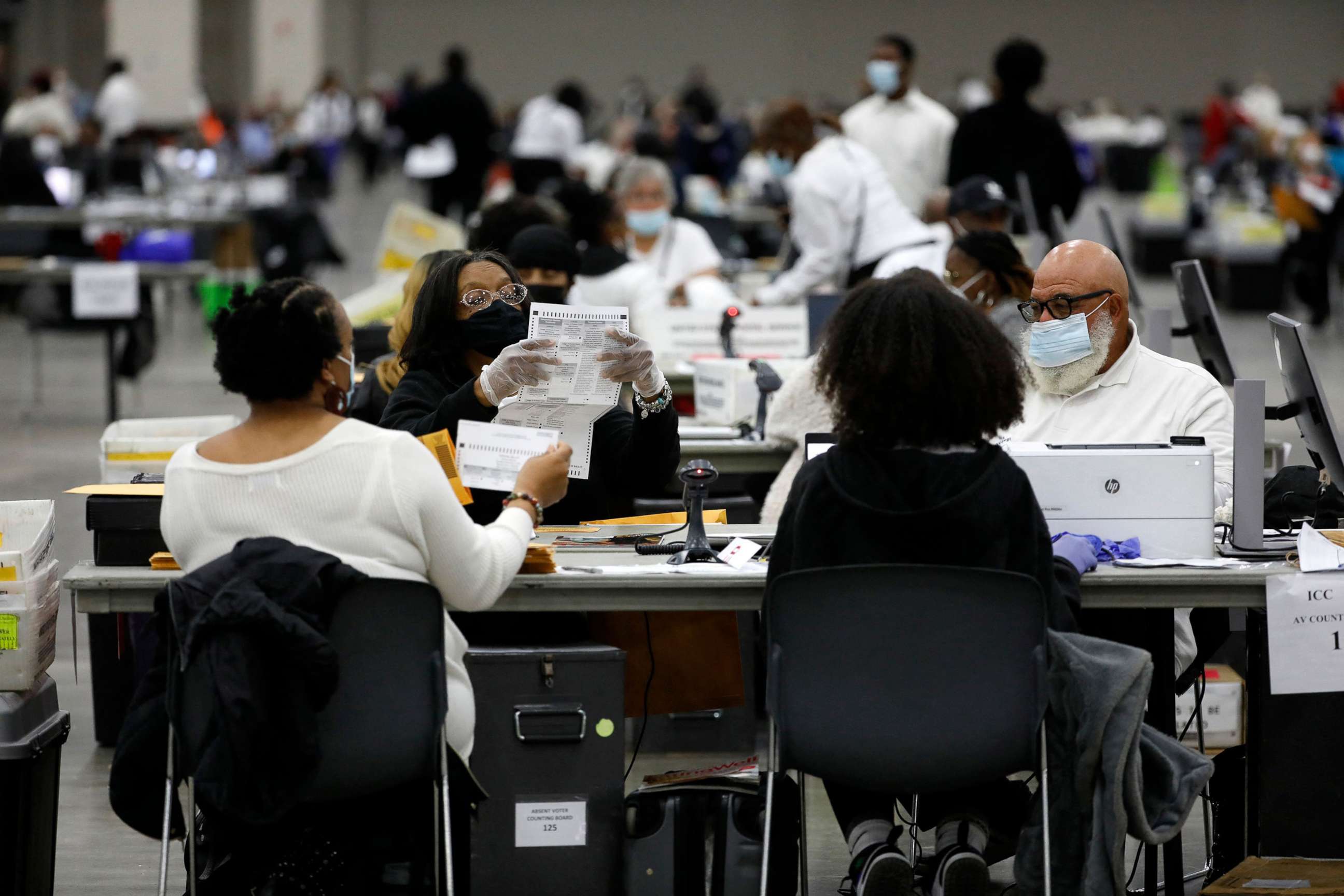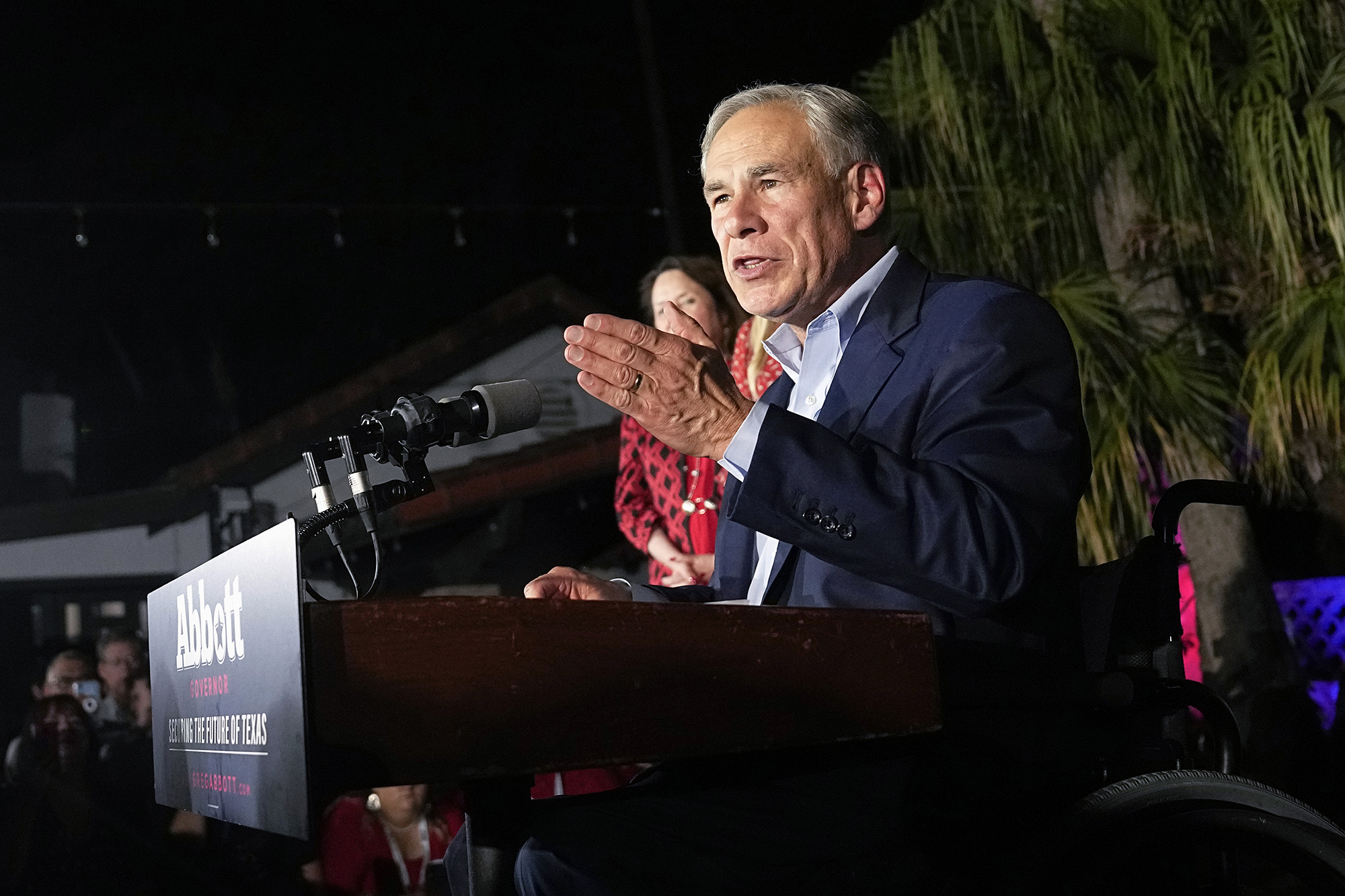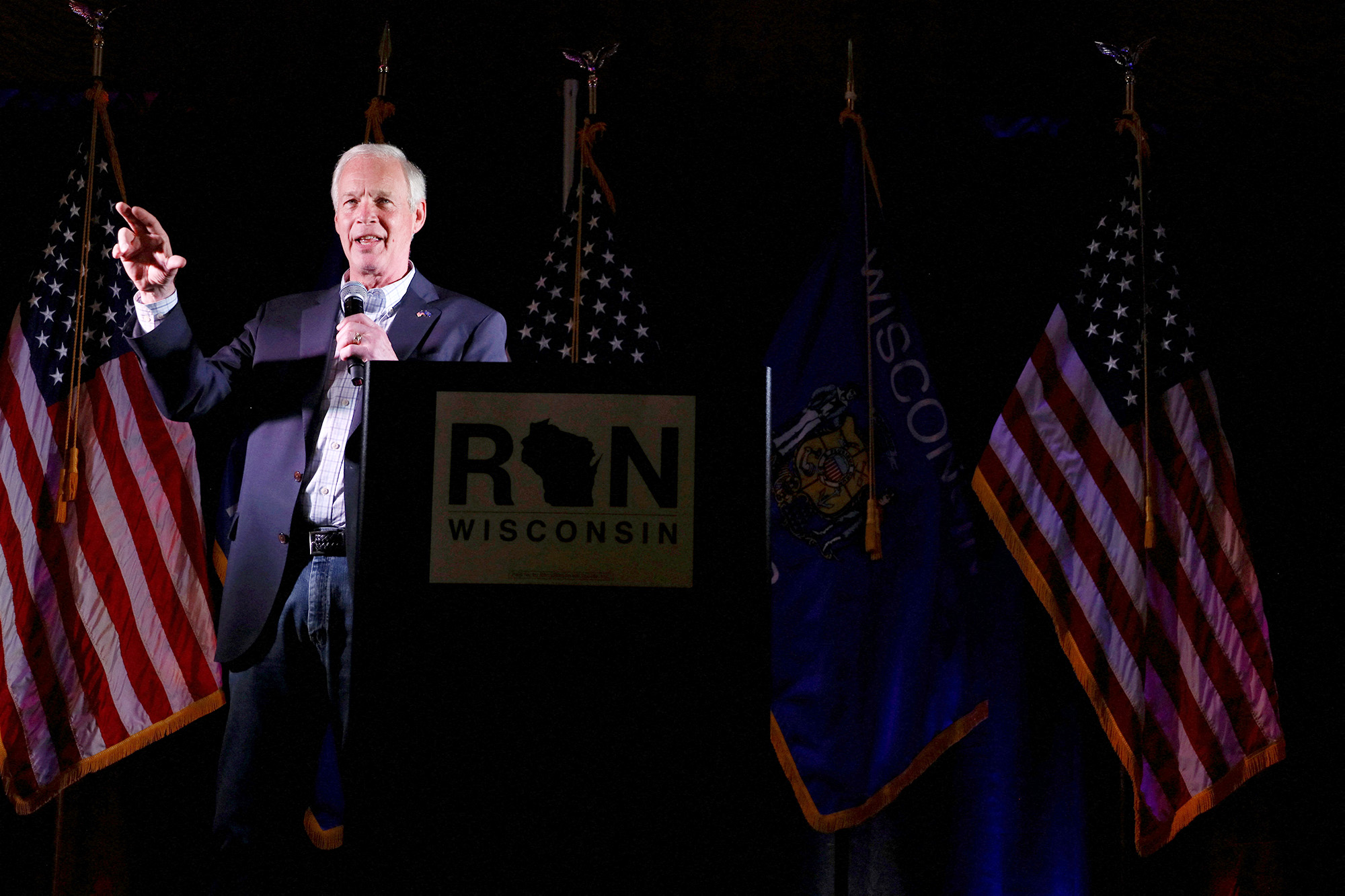Democrats fend off headwinds from Biden and economy: Exit poll analysis
Several Senate seats and control of the House remains unsettled.
Democrats pushed back against historic trends in the 2022 midterms, overcoming broadly negative economic attitudes and Joe Biden’s unpopularity to hold more seats than typical in the face of such headwinds.
Their competitiveness came down to a variety of factors -- support for abortion rights, negative views of Donald Trump, rejection of election denial, broad backing from young voters and surprising strength among independents among them. The result was a battle in the trenches, district by district and state by state, for House and Senate control.
The hurdle for Democrats was high with 76% in ABC News exit poll results rating the economy negatively, 24 percentage points more than two years ago when Biden took office and 45 points more than in the last midterms four years ago. Additionally, 47% said their own finances have gotten worse in the last two years, the most dating to 1982 and just 44% approved of Biden’s work in office, among the lowest midterm presidential approval ratings in 40 years.

All those typically produce deep losses for the party in power. Yet the Democrats bucked the trend. Even with several Senate seats and House control unsettled in the wee hours, it was clear they’d dodged the level of damage usually associated with this extent of discontent.
Abortion was one factor. It ranked a strong second as the top issue -- behind inflation -- and voters who picked it went for Democratic candidates by 76-23%. Among all voters, the Democratic Party led by 53-42% in trust to handle abortion. Six in 10 said it should be legal in all or most cases, up 9 points from just two years ago, as many were critical of the U.S. Supreme Court decision eliminating the constitutional right to an abortion. In fact, women were 11 points more apt than men to cite abortion as their top issue, but women did not turn out, nor vote Democratic, in larger than usual numbers.
Then there were young voters, age 18 to 29. Within this group, 44% picked abortion as their top issue, twice as many as those that picked inflation. Among voters age 30 and older, far fewer named abortion as their top issue – just 25%. While young people made up about 12% of voters -- their typical midterm turnout -- they voted Democratic by 63-35%, as in a winning Democratic year.
On another front, days before his pending announcement of another run for the White House, rejection of Trump was as broad as it was of Biden: 58% saw Trump unfavorably, with 56% feeling the same of Biden.
Other results pointed to election confidence. Countering election denial, 79% of voters were confident in the fairness and accuracy of the elections in their state. A plurality, 47%, were very confident, and those very confident in their elections backed Democratic candidates by 70-28%. Further, voters by 61-35% said Biden was legitimately elected. The House vote among that majority was 74-24%, a 3-1 Democratic margin.

Then there were independents. Nationally, in strong Republican years, they break for the Republican Party -- by 7 points in 2016, 14 in 2014 and 19 in 2010. This year, independents split 49-47% between Democratic and Republican House candidates.
While 93% of Democrats said Biden was legitimately elected, so did 64% of independents, while only 28% of Republicans felt this. And among independents who accepted Biden as legitimate, 68% voted Democratic for House -- another result that helped stanch the party’s potential losses.
A summary of state-by-state exit poll results in key races follows.
Arizona
With no winner Wednesday morning, exit poll results were full of reasons why the Arizona gubernatorial race was so close. Democrat Katie Hobbs was helped by a 17-point margin among college-educated whites, a group that split essentially evenly in 2018 when Republican Doug Ducey won. Yet Republican and 2020 election-denier Kari Lake struck back with a 95-point margin among the 35% who do not think Biden legitimately won the presidency in 2020. And the two were neck-and-neck in massive Maricopa County, 50-49%, Lake-Hobbs.

In another still-unsettled race, moderates, who made up 42% of Arizona voters, backed incumbent Democrat Mark Kelly over Republican Blake Masters, 63-33%. But 52% said Biden’s policies are mostly hurting the country, and they went for Masters, 87-9%. Kelly did well in his home Pima County, while Masters had a lead in the rest of the state. In one difference, 54% percent said political newcomer Masters’ views are too extreme; fewer, 43%, said the same of Kelly’s, though these exit poll results were still preliminary.
Florida
A growing Republican electorate may mark an end to Florida’s position as a swing state, with incumbent Gov. Ron DeSantis and Sen. Marco Rubio securing decisive victories against their Democratic opponents. Florida Republicans outnumbered Democrats by 14 points, up from 8 points in 2020 and 4 points in 2018 to the widest GOP margin in exit polls since 1988.

Notable swings among Hispanic voters, particularly non-Cuban Hispanic voters, also helped DeSantis and Rubio win. Hispanics voters overall broke for DeSantis by 15 points, 57-42%, compared with a 10-point win for Democrat Andrew Gillum in 2018. This included a 5-point DeSantis win among non-Cuban Hispanic voters, a sharp reversal from 2018, when they went for Gillum by 30 points. Shifts among non-Cuban Hispanic voters were also similar in Rubio’s race. By region, voters in Miami and the Gold Coast, the state’s most Democratic region, were evenly split in both the Senate and governor’s races, compared with a +30 Democratic margin in the 2018 gubernatorial race and +16 when Rubio was last elected.
Georgia
In the Senate race, Republican Herschel Walker, who was embroiled in a personal scandal, was seen as having good judgment by just a third of Georgia voters; half said the same about Democratic Sen. Raphael Warnock. At the same time, Warnock was seen as having views that are “too extreme” by 49%, vs. 43% who said so for Walker.
The winner on the gubernatorial side, incumbent Gov. Brian Kemp, improved over his 2018 matchup with Democrat Stacey Abrams by shoring up support among key Republican groups, including conservatives (+80 points, vs. +67 in 2018), rural and small city residents (+35 points, vs. +16 in 2018) and evangelical white Christians (+83 points, vs. +77 in 2018). Independents also were a factor, voting 49-48%, Kemp-Abrams; they went 54-44%, Abrams-Kemp, in 2018.

Michigan
In the governor’s race, incumbent Democrat Gretchen Whitmer was boosted by abortion on the ballot with 54% of voters voting yes on the proposition to establish the right to an abortion and 89% in this group backed Whitmer. Additionally, 45% said abortion was one of the most important issues in their vote choice in Michigan, 18 points higher than seen in national exit poll results and easily outpacing inflation as the top concern. Among abortion voters, 75% supported Whitmer. She also won 51% of suburban voters, a group she lost by 3 points in her 2018 election.
Nevada
With no winner in Nevada’s Senate race projected as of Wednesday morning, exit poll data found Republican Adam Laxalt eroding normally wide Democratic margins in Clark County, the home of Las Vegas and more than seven in 10 of the state’s voters. Democratic incumbent Catherine Cortez Masto led by 4 points there, vs. 12 points in 2016. While that typically would be a death knell for a Democrat in Nevada, Cortez Masto came back with a 12-point lead in Washoe County, the second most populous county in the state; it was decided by just 1 point in the past two Senate elections. And independent voters, who Cortez Masto lost by 10 points in 2016, split 48-45%, Cortez Masto-Laxalt.
In another race with no winner projected as of Wednesday morning, Republican Joe Lombardo was aided by the share of voters age 65 and older, 32%, up 10 points vs. 2018. He won older voters by 13 points over incumbent Democrat Steve Sisolak. Lombardo won white men by a 24-point margin. Sisolak was helped by political moderates, 55-41%, and racial and ethnic minorities, 66-31%.
New Hampshire
Popular Republican Gov. Chris Sununu rode to re-election with a 69% job approval rating. In a state that has two Democratic senators and has voted for Democratic presidents in five straight contests, his appeal as a moderate was key. He won among independents by 21 points, 59-38%, and was able to sway otherwise Democratic voters; in an impressive crossover, 21% of those who voted for Democratic Sen. Maggie Hassan also voted for Sununu.
Hassan prevailed with support from moderates. She won by 27 points among this group, far outpacing her 6-point advantage among moderates in 2016. Further, abortion looked critical: 35% of voters identified it as the top issue in their vote, and Hassan won this group by 73 points with only 36% picking inflation as their top issue, but Republican challenger Don Bolduc won them by less of a margin, 42 points. Another key group for Hassan: While six years ago she held a 7-point advantage among women, that margin expanded to 19 points in this election.
North Carolina
A total of 80% of North Carolina rated the nation’s economy negatively and 61% voted for Republican Senate candidate Ted Budd. He also won 62% of white voters. And Budd, who owns a gun store, won 65% of voters from gun-owning households, 68% of all voters in the state.
Ohio
Incumbent Republican Gov. Mike DeWine won another term with 65% job approval among Ohio voters. As in 2018, DeWine won big among non-college white men (+47 points), whites (+33), men (+31 points) and rural residents (+22).

Political newcomer and Republican J.D. Vance was helped by Ohio’s recent red-state status: Thirty-six% of Ohio voters were conservatives, compared with 21% liberals. He won by 64-36% among the 75% who rated the economy negatively, and won suburbanites by 13 points, 56 vs. 43%.
Pennsylvania
Among key storylines in the state’s Senate race, projected winner John Fetterman focused on Mehmet Oz’s newcomer status in Pennsylvania and his longtime New Jersey residency. Just 43% of voters thought Oz had lived in Pennsylvania long enough to represent the state effectively in the U.S. Senate. By contrast, half thought Fetterman is in good enough health to represent the state effectively; questions over his health circulated since his stroke in May and his Oct. 25 debate performance.

The winner in the governor’s race, Democrat Josh Shapiro, was boosted by the strongest showing for a winning gubernatorial candidate in the state among moderates (+40 points) in available data since 1992 and among independents (+29 points) since 2006.
Texas
While Beto O’Rourke ran a closer race than Gov. Greg Abbott’s Democratic challenger Lupe Valdez in 2018, he was ultimately unable to gather the support he had in his last race for statewide office – one he lost by just 3 points in one of the closest Texas Senate races in decades. In 2018, O’Rourke won Hispanic and Latino voters by 29 points against Cruz; this year he won them by a slimmer 17-point margin.

O’Rourke also was unable to mobilize Hispanic and Latino voters in the same way that he did in 2018, with turnout down 5 points among them, 26 vs. 21%. O’Rourke’s margins similarly slid among voters age 18-29, from +42 points against Cruz four years ago to +29 points; and among women, flipping from an 8-point win against Cruz to a 3-point loss against Abbott. Abbott retained broad support among evangelical white Christian voters (+76 points), conservatives (+82 points) and voters in East (+52 points) and West (+49 points) Texas.
Wisconsin
Incumbent Gov. Tony Evers edged out a narrow victory against Republican challenger Tim Michels, almost exactly matching his margin against Republican incumbent Scott Walker four years ago. Evers was aided by his popularity, with 53% percent approving of how he’s handling his job as governor. He also won by 19 points among moderates, who accounted for a plurality of voters in the state, 39%; and by a narrow 2 points among independents, who have backed the winning candidate in all Wisconsin governor races for which data are available since 1994.

The Wisconsin Senate race has not been projected as of Wednesday morning with 47% saying Democrat Mandela Barnes’ views are too extreme, while essentially as many, 48%, said the same about incumbent Republican Ron Johnson. Mandela won by 81-19% among the 31% of voters who called abortion a top issue in their vote; Johnson, by 77-23% margin among the 35% citing inflation. In a notable shift among groups, young voters broke sharply for Barnes, 69-31%, compared with a narrow +3 points for Johnson in 2016. Still, they accounted for 11% of voters, vs. 14% six years ago. Those aged 65 and older, by contrast, were up from 24% of voters in 2016 to 33% this year, and broke 54-45% for Johnson.




